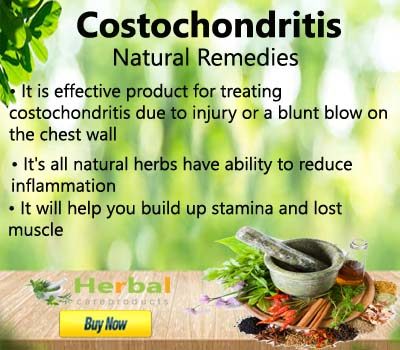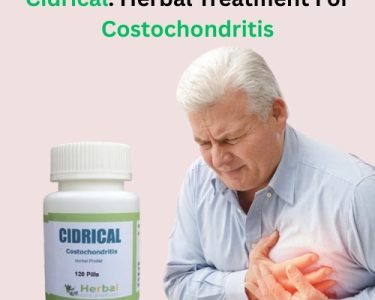Costochondritis
Inflammation of the cartilage that connects the ribs and breastbone is what causes this painful illness. The costochondrial joint is where this is located. Costochondritis, costosternal syndrome, and chest wall pain are additional names for the condition. Tietze syndrome is a condition that has edoema. The left side is typically the more impacted. Since the symptoms of costochondritis frequently resemble those of a heart attack, a thorough diagnosis is crucial.
Sharp or painful chest pain, pain on the left side of the sternum, pain in at least one rib, but frequently more, pressure in the chest, increased pain with deep breathes, coughing, lifting, or engaging in other strenuous activities are the most typical costochondritis indications and symptoms. Respiratory infections like pneumonia, tumours in the chest that grow on, irritate, or press against the cartilage linking the ribs to the breastbone, injuries or trauma to the chest, etc. are the most typical causes of costochondritis.
Being 40 years of age or older, having allergies, participating in high-impact activities, being a woman, performing manual labour or heavy lifting, having rheumatoid arthritis, ankylosing spondylitis, or reactive arthritis are some characteristics that enhance your risk of developing costochondritis [1]. Before using any of the home remedies listed below for costochondritis, if you have this condition, you should consult your doctor. Following are some Natural Treatments for Costochondritis:
Apply heat to the affected area in Costochondritis
Studies have shown that heating pads can effectively reduce the pain and inflammation brought on by costochondritis. Heat should not be applied for longer than 15 minutes at a time. In order to prevent skin harm, you should wrap the heat source in a washcloth or towel.
You should avoid applying the heat source directly to your skin and instead use a heating blanket or hot water bottle. To avoid burning yourself, you should cover a hot water bottle in a towel before using it. For your skin to have a chance to calm down, you should apply the heat for a few minutes and then remove it. This natural remedy might aid in boosting blood flow and loosening up any stiff muscles.
Avoid activities that require sharp, sudden movements or exert high stress on your chest
Sports like karate, golf, tennis, basketball, and baseball may need to be put on hold until your condition gets better and the discomfort goes away completely.
Apply cold to the affected area
The painful location where the sternum and ribs attach is known as the joint. Ice can help to reduce swelling and calm irritation. A bag of frozen peas or corn that has been wrapped in a towel can be used as a quick and convenient ice pack. The ice shouldn’t be put on your skin directly. You should take off the ice pack and let your skin warm up after 15 to 20 minutes. This natural remedy should be repeated three to four times daily.
Side Stretch
Your hands should be placed on the lower thighs when you sit down with your legs straight out in front of you and a good straight back. Lean forward while bending your right arm. To allow your hand to slice across your left leg, try to bring your right elbow down to your knee on that side.
Holding your elbow against the inside of your right knee will allow you to stretch yourself even further by turning your chest even farther to the left. Release gradually, then take a step back to the starting position. Repetition with the left side of the body is required. Each side should be stretched ten to twelve times every session, alternating sides.
Get enough rest
Allowing your body to heal is crucial since doing so will relieve your costochondritis symptoms. Find a position that is both comfortable for you and does not make your problem worse. You should unwind and breathe quietly and calmly. You shouldn’t pant because doing so can make your pain worse.
Thorax stretch
Your back should remain nice and straight as you sit down with your legs extended straight in front of you. You should slowly lean forward while placing your hands on the floor at the side of your thighs. In order for your belly button to go toward your spine, you should curl over your legs. Hold for a few seconds, then raise yourself slowly. Per session, you should repeat 5–10 times.
Change sleep positions
When you go to sleep, you should try with several positions to see which one causes you the least discomfort. Avoiding positions that exert strain on your hurting joints is a good idea. You should switch positions because sleeping on your stomach could be painful.
Stretch the pecs
Standing just outside a doorway, raise your arms on either side of the frame as high as you can. You should straighten your body and chest while supporting your weight with your hands. So that your back does not sag or arch, maintain your abs taut. Hold for a short while before going back to the beginning position. Per session, you should repeat 5–10 times.
Anti – inflammatory diet
Foods with anti-inflammatory properties should be added to your diet because they have many health advantages besides only reducing inflammation brought on by costochondritis. It can lessen pain and inflammation while also transforming your health. These foods are also nutrient-rich. You should concentrate on eating a varied diet that is high in fruits and vegetables.
Beets, mushrooms, peppers, broccoli, avocados, cherries, bok choy, cabbage, pineapple, tomatoes, green leafy vegetables (like spinach and kale), grapes, and berries are some healthy foods you can include in your diet. Blueberries, raspberries, and strawberries are a few berries you should include in your diet. Additionally, foods that contain sulphur, such as onion and garlic, can aid in the fight against costochondritis.
You need to increase the amount of good fats in your diet by eating foods like coconut oil, olive oil, fatty salmon, and walnuts. Chia seeds, ground flaxseeds, cocoa, and dark chocolate are additional foods you can include in your diet. You may increase the anti-inflammatory effects of the dishes you cook by adding ginger, turmeric, and bone broth. Green tea is one of the greatest over-the-counter treatments for costochondritis if you enjoy drinking tea.
Foods to avoid in Costochondritis
Many pro-inflammatory foods and substances are prohibited from the anti-inflammatory diet that is used to treat costochondritis. Avoid soda, baked goods, bread, packaged snacks, processed foods, refined grains, refined sugars, and baked goods. It is believed that dairy products and foods containing gluten can cause inflammation. You should drink dairy-free foods like almond, rice, or coconut milk as well as gluten-free quinoa- or rice-based foods. Additionally, since it is known that stimulants like caffeine and alcohol can make the inflammation worse, you should stay away from them.
Turmeric
This natural remedy is well known for its ability to combat inflammation, but it can also aid in the treatment of arthritis. It can lessen the discomfort and stop the inflammation from spreading.
To ease the stress on your chest, improve your posture.
According to several research, having a slumped posture when sitting or standing can make your costochondritis worse and make you more uncomfortable. You should get comfortable sitting, standing, and moving around while holding a book on your head. Your focus should be on expanding your chest and allowing your shoulders to drop.
Noni fruit
According to certain research, consuming noni fruit or noni juice can help you reduce the pain brought on by costochondritis.
Omega – 3 fatty acids
These fatty acids have a crucial role in regulating the body’s inflammation. You can treat costochondritis at home by taking omega-3 fatty acids.
Scapula squeeze
You should take a tall, upright stance, raise your hand to the ceiling, and breathe easily. Your shoulder blades should be squeezed together, and you should hold the pressure for whatever long it is comfortable. then let go. This exercise should be done five to ten times during each session.




